Semantics_语义学
- 格式:docx
- 大小:20.13 KB
- 文档页数:2
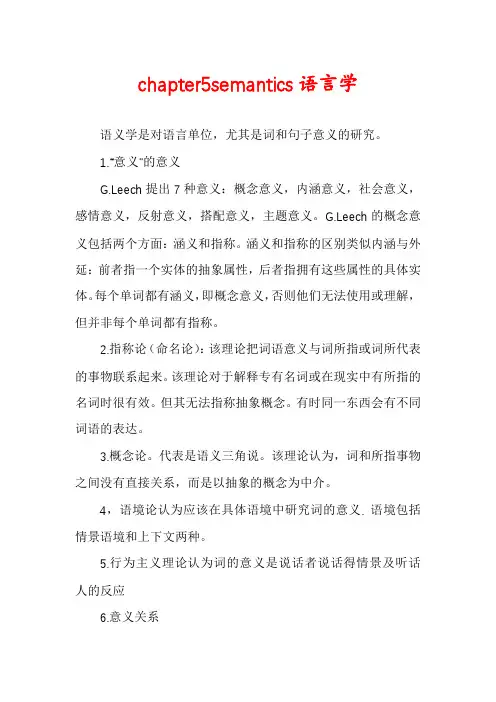
chapter5semantics语言学语义学是对语言单位,尤其是词和句子意义的研究。
1.“意义”的意义G.Leech提出7种意义:概念意义,内涵意义,社会意义,感情意义,反射意义,搭配意义,主题意义。
G.Leech的概念意义包括两个方面:涵义和指称。
涵义和指称的区别类似内涵与外延:前者指一个实体的抽象属性,后者指拥有这些属性的具体实体。
每个单词都有涵义,即概念意义,否则他们无法使用或理解,但并非每个单词都有指称。
2.指称论(命名论):该理论把词语意义与词所指或词所代表的事物联系起来。
该理论对于解释专有名词或在现实中有所指的名词时很有效。
但其无法指称抽象概念。
有时同一东西会有不同词语的表达。
3.概念论。
代表是语义三角说。
该理论认为,词和所指事物之间没有直接关系,而是以抽象的概念为中介。
4,语境论认为应该在具体语境中研究词的意义. 语境包括情景语境和上下文两种。
5.行为主义理论认为词的意义是说话者说话得情景及听话人的反应6.意义关系词语词之间的主要意义关系:相同关系,相反关系,包含关系a.同义关系。
完全同义关系很少,所谓的同一都依赖语境,并总在某方面不同。
(方言,内涵,文体等)b.反义关系主要包括:等级反义关系,互补反义关系,关系反义关系。
1)等级反义的特点:第一,否定一方并不必然是肯定另一方,还有中间状态;第二,没有绝对评判标准,标准随对象而改变。
第三,通常用其中表示较高程度的词来覆盖整个量级。
覆盖性词被称为“无标记的”,即一般性的;被覆盖词被称为“有标记的”,即特殊的。
一般使用覆盖性词语。
一旦使用被覆盖词语,表示有某种特殊的、不一般的情况。
第四,可用very修饰,可有比较级最高级2)互补反义关系,第一,肯定一方意味着否定另一方。
反之亦然。
第二,不用very修饰,没有比较级最高级。
第三,评判标准绝对。
没有覆盖性词语3)关系(反向)反义关系,表现两个实体间的一种反向关系,不构成肯否定对立。
一个预设着另一个的存在。
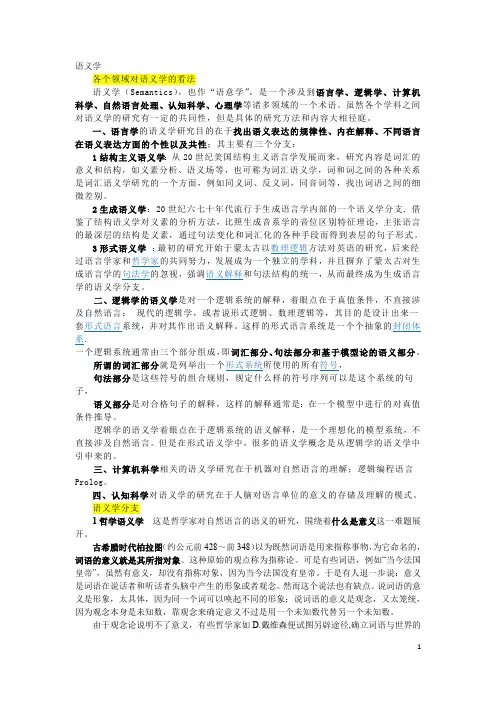
语义学各个领域对语义学的看法语义学(Semantics),也作“语意学”,是一个涉及到语言学、逻辑学、计算机科学、自然语言处理、认知科学、心理学等诸多领域的一个术语。
虽然各个学科之间对语义学的研究有一定的共同性,但是具体的研究方法和内容大相径庭。
四、认知科学对语义学的研究在于人脑对语言单位的意义的存储及理解的模式。
语义学分支1哲学语义学 这是哲学家对自然语言的语义的研究,围绕着什么是意义这一难题展开。
古希腊时代柏拉图(约公元前428~前348)以为既然词语是用来指称事物,为它命名的,词语的意义就是其所指对象。
这种原始的观点称为指称论。
可是有些词语,例如“当今法国皇帝”,虽然有意义,却没有指称对象,因为当今法国没有皇帝。
于是有人退一步说:意义是词语在说话者和听话者头脑中产生的形象或者观念。
然而这个说法也有缺点。
说词语的意义是形象,太具体,因为同一个词可以唤起不同的形象;说词语的意义是观念,又太笼统,因为观念本身是未知数,靠观念来确定意义不过是用一个未知数代替另一个未知数。
由于观念论说明不了意义,有些哲学家如D.戴维森便试图另辟途径,确立词语与世界的联系。
他们提出, 语句的意义与命题的真假有关。
这种观点称为真值论。
在真值论基础上发展出真值条件语义学,可能世界语义学及各种模式 -理论语义学。
维特根斯坦(1889~1951)反对真值论,他认为词的意义是它在语言中的用法。
他的理论叫做用法论。
用法论不象真值论那么狭窄,因为许多语句没有所谓真值,如疑问句、祈使句都无所谓真假,但是任何词语必有一定的用法。
可是用法论也有缺陷,困为“用法”的概念不明确。
后期的语言游戏论,认为“语言游戏论=自然语言分析+心理行为分析”。
维特根斯坦后期的转变不仅是语言基础的转变———从理想语言转到自然语言,也是分析方法的转变———从单纯的语言分析转到语言分析与心理分析的结合。
英国哲学家J.L.奥斯汀 (1911~1960)也反对真值论,他从另一个角度来弥补真值论的不足,他认为说话不仅是“言”,而且是“行”,因而话语有双重作用,一是陈述命题,二是起命令、请求、许愿、警告之类的言外作用。
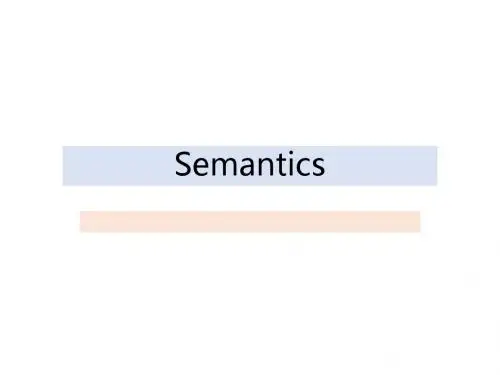
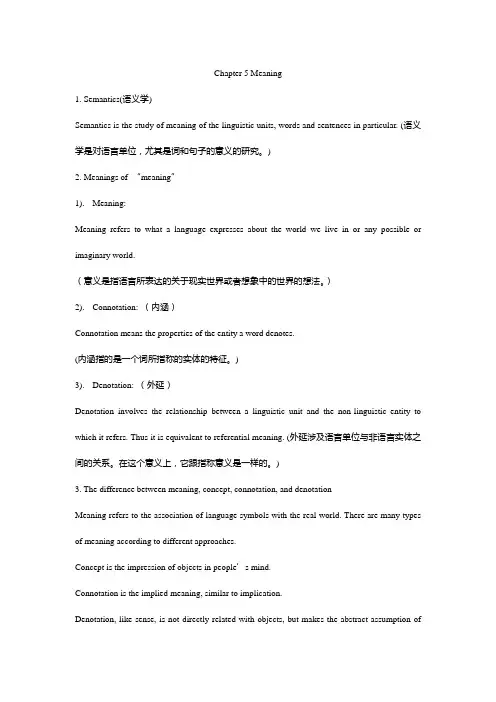
Chapter 5 Meaning1. Semantics(语义学)Semantics is the study of meaning of the linguistic units, words and sentences in particular. (语义学是对语言单位,尤其是词和句子的意义的研究。
)2. Meanings of “meaning”1). Meaning:Meaning refers to what a language expresses about the world we live in or any possible or imaginary world.(意义是指语言所表达的关于现实世界或者想象中的世界的想法。
)2). Connotation: (内涵)Connotation means the properties of the entity a word denotes.(内涵指的是一个词所指称的实体的特征。
)3). Denotation: (外延)Denotation involves the relationship between a linguistic unit and the non-linguistic entity to which it refers. Thus it is equivalent to referential meaning. (外延涉及语言单位与非语言实体之间的关系。
在这个意义上,它跟指称意义是一样的。
)3. The difference between meaning, concept, connotation, and denotationMeaning refers to the association of language symbols with the real world. There are many types of meaning according to different approaches.Concept is the impression of objects in people’s mind.Connotation is the implied meaning, similar to implication.Denotation, like sense, is not directly related with objects, but makes the abstract assumption ofthe real world.4. The referential theory1). DefinitionThe theory of meaning which relates the meaning of a word to the thing it refers to, or stands for, is known as the referential theory.(把词语意义跟它所指称或代表的事物联系起来的理论,叫做指称理论)2). The semantic triangle (语义三角)Ogden and Richards presented the classic “Semantic Triangle”as manifested in the following diagram。
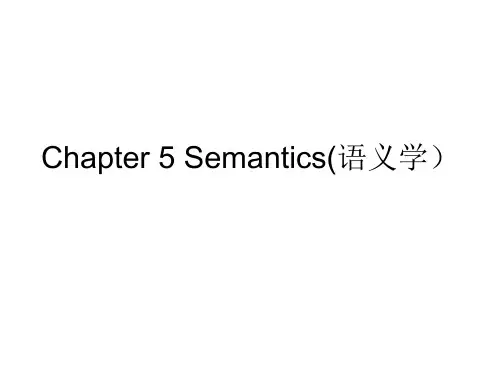
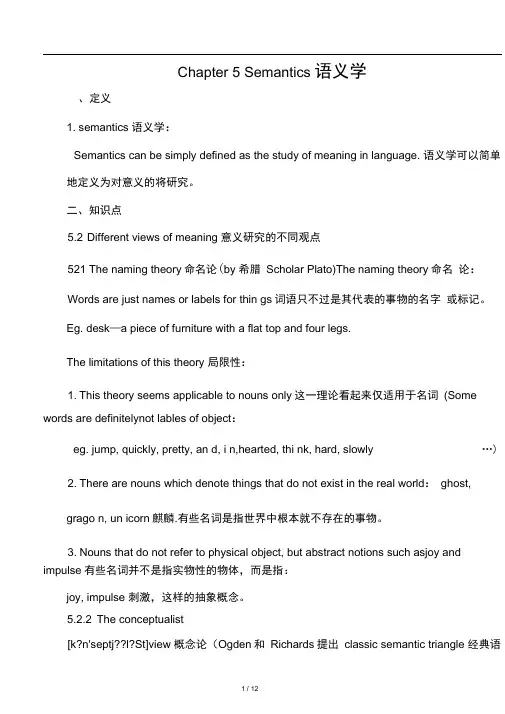
Chapter 5 Semantics 语义学、定义1. semantics 语义学:Semantics can be simply defined as the study of meaning in language. 语义学可以简单地定义为对意义的将研究。
二、知识点5.2 Different views of meaning 意义研究的不同观点521 The naming theory命名论(by 希腊Scholar Plato)The naming theory命名论:Words are just names or labels for thin gs词语只不过是其代表的事物的名字或标记。
Eg. desk—a piece of furniture with a flat top and four legs.The limitations of this theory 局限性:1. This theory seems applicable to nouns only这一理论看起来仅适用于名词(Some words are definitelynot lables of object:eg. jump, quickly, pretty, an d, i n,hearted, thi nk, hard, slowly …)2. There are nouns which denote things that do not exist in the real world: ghost,grago n, un icorn麒麟.有些名词是指世界中根本就不存在的事物。
3. Nouns that do not refer to physical object, but abstract notions such asjoy and impulse有些名词并不是指实物性的物体,而是指:joy, impulse 刺激,这样的抽象概念。
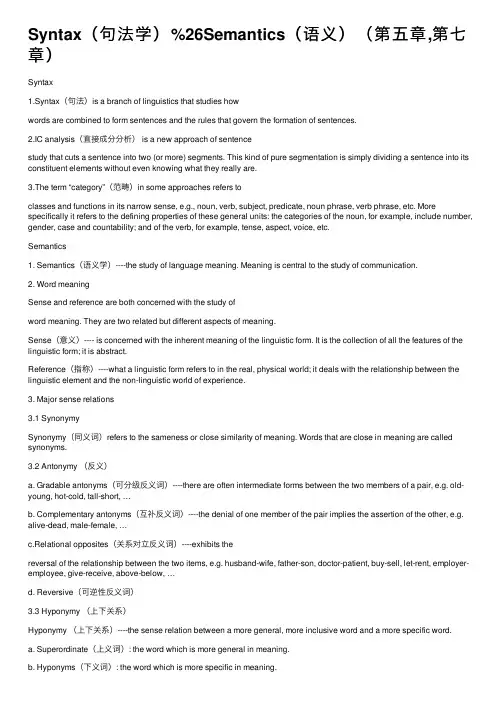
Syntax(句法学)%26Semantics(语义)(第五章,第七章)Syntax1.Syntax(句法)is a branch of linguistics that studies howwords are combined to form sentences and the rules that govern the formation of sentences.2.IC analysis(直接成分分析) is a new approach of sentencestudy that cuts a sentence into two (or more) segments. This kind of pure segmentation is simply dividing a sentence into its constituent elements without even knowing what they really are.3.The term “category”(范畴)in some approaches refers toclasses and functions in its narrow sense, e.g., noun, verb, subject, predicate, noun phrase, verb phrase, etc. More specifically it refers to the defining properties of these general units: the categories of the noun, for example, include number, gender, case and countability; and of the verb, for example, tense, aspect, voice, etc.Semantics1. Semantics(语义学)----the study of language meaning. Meaning is central to the study of communication.2. Word meaningSense and reference are both concerned with the study ofword meaning. They are two related but different aspects of meaning.Sense(意义)---- is concerned with the inherent meaning of the linguistic form. It is the collection of all the features of the linguistic form; it is abstract.Reference(指称)----what a linguistic form refers to in the real, physical world; it deals with the relationship between the linguistic element and the non-linguistic world of experience.3. Major sense relations3.1 SynonymySynonymy(同义词)refers to the sameness or close similarity of meaning. Words that are close in meaning are called synonyms.3.2 Antonymy (反义)a. Gradable antonyms(可分级反义词)----there are often intermediate forms between the two members of a pair, e.g. old-young, hot-cold, tall-short, …b. Complementary antonyms(互补反义词)----the denial of one member of the pair implies the assertion of the other, e.g. alive-dead, male-female, …c.Relational opposites(关系对⽴反义词)----exhibits thereversal of the relationship between the two items, e.g. husband-wife, father-son, doctor-patient, buy-sell, let-rent, employer-employee, give-receive, above-below, …d. Reversive(可逆性反义词)3.3 Hyponymy (上下关系)Hyponymy (上下关系)----the sense relation between a more general, more inclusive word and a more specific word.a. Superordinate(上义词): the word which is more general in meaning.b. Hyponyms(下义词): the word which is more specific in meaning.c. Co-hyponyms(同级下义词): hyponyms of the same superordinate.e.g. Superordinate: furnitureHyponyms: bed, table, desk, dresser, wardrobe, sofa, …3.4 Polysemy (⼀词多义)----the same one word may have more than one meaning.3.5 HomonymyHomonymy---- the phenomenon that words having different meanings have the same form, e.g. different words are identical in sound or spelling, or in both.Homophone(同⾳异义词)---- when two words are identical insound, e.g. rain-reign, night/knight, …Homogragh(同形异义词)---- when two words are identical in spelling, e.g. tear(n.)-tear(v.), lead(n.)-lead(v.), …Complete homonym---- when two words are identical in both sound and spelling4. Componential analysis(成分分析)---- a way to analyze lexical meaning. The approach is based on the belief that the meaning of a word can be dissected into meaning components, called semantic features. For example,Man: [+HUMAN, +ADULT, +ANIMATE, +MALE]Boy: [+HUMAN, -ADULT, +ANIMATE, +MALE]Woman: [+HUMAN, +ADULT, +ANIMATE, -MALE]Girl: [+HUMAN, -ADULT, +ANIMATE, -MALE]Pragmatics语⽤学Pragmatics is the study of how speakers of a language usesentences to effect successful communication.Pragmatics is the study of speaker meaning, contextualmeaning, how more gets communicated than is said.The originSemanticsContext considered Context unconsideredPragmatics Traditional semanticsSentence and utterance话语The relation: Meaning of a sentence is abstract anddecontextualized while meaning of an utterance isconcrete and context-dependent. The meaning of anutterance is based on a sentence meaning and therealization of the abstract meaning of a sentencein a real situation of communication.Example: My bag is heavy. (utterance meaning: a statement,indirec t or polite request, declining someone’s requestfor help)Cooperative Principles and violation of the conversation maxims合作原则和准则的违反The maxim of quantity 数量准则Make your utterance as informative as required. No more and no less.The maxim of quality 质量准则Do not say what you believe to be false and do not saywhat you lack evidence for.The maxim of relation 关系准则Be relevantThe maxim of manner ⽅式准则Avoid obscurity, ambiguity. Be brief and orderly Violation of the maxims and revealing conversation implicature 会话含义The use of the terms principle and maxim does not meanthat the CP and its maxims will be followed by everybody all the time. People do violate them and tell lies. In fact, the significance CP lies in the violations.Examples of the violations of the maxims:1) Violation of the Maxim of QuantityA: What are you readingB: A book.A: Do you know where Dr. Townsend livesB: Somewhere in the southern suburbs of the city. (saidwhen it is known to both A and B that B has Dr. Townsend’s address)2)Violation of the Maxim of QualityA: Would you like to come to our party tonightB: I’m afraid I’m not feeling so well today.(said when it is known to both A and B thatB is feeling perfectly well)3) Violation of the Maxim of RelationA: What time is itB: Well, the paper’s already come.A: The hostess is an awful bore. Don’t you thinkB: The roses in the garden are beautiful, aren’t theyA: What do you think of the lectureB: He’s a good cook.4) Violation of the Maxim of MannerA: Let’s stop and get something to eat.B: Okay, but not M-c-D-o-n-a-l-d-s.A: What did your sister buy at Sears yesterdayB: She bought a red dress, she bought a green dress, and she bought a blue dress.。
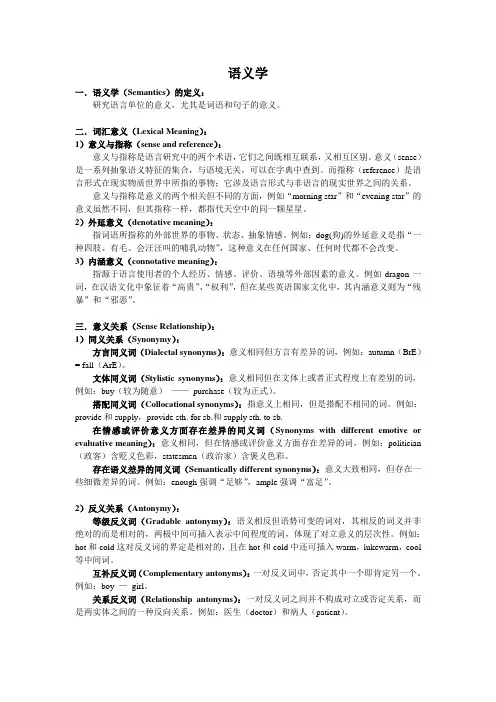
语义学一.语义学(Semantics)的定义:研究语言单位的意义,尤其是词语和句子的意义。
二.词汇意义(Lexical Meaning):1)意义与指称(sense and reference):意义与指称是语言研究中的两个术语,它们之间既相互联系,又相互区别。
意义(sense)是一系列抽象语义特征的集合,与语境无关,可以在字典中查到。
而指称(reference)是语言形式在现实物质世界中所指的事物;它涉及语言形式与非语言的现实世界之间的关系。
意义与指称是意义的两个相关但不同的方面,例如“morning star”和“evening star”的意义虽然不同,但其指称一样,都指代天空中的同一颗星星。
2)外延意义(denotative meaning):指词语所指称的外部世界的事物、状态、抽象情感。
例如:dog(狗)的外延意义是指“一种四肢、有毛、会汪汪叫的哺乳动物”,这种意义在任何国家、任何时代都不会改变。
3)内涵意义(connotative meaning):指源于语言使用者的个人经历、情感、评价、语境等外部因素的意义。
例如dragon一词,在汉语文化中象征着“高贵”、“权利”,但在某些英语国家文化中,其内涵意义则为“残暴”和“邪恶”。
三.意义关系(Sense Relationship):1)同义关系(Synonymy):方言同义词(Dialectal synonyms):意义相同但方言有差异的词,例如:autumn(BrE)= fall(ArE)。
文体同义词(Stylistic synonyms):意义相同但在文体上或者正式程度上有差别的词,例如:buy(较为随意)——purchase(较为正式)。
搭配同义词(Collocational synonyms):指意义上相同,但是搭配不相同的词。
例如:provide和supply,provide sth. for sb.和supply sth. to sb.在情感或评价意义方面存在差异的同义词(Synonyms with different emotive or evaluative meaning):意义相同,但在情感或评价意义方面存在差异的词,例如:politician (政客)含贬义色彩,statesmen(政治家)含褒义色彩。
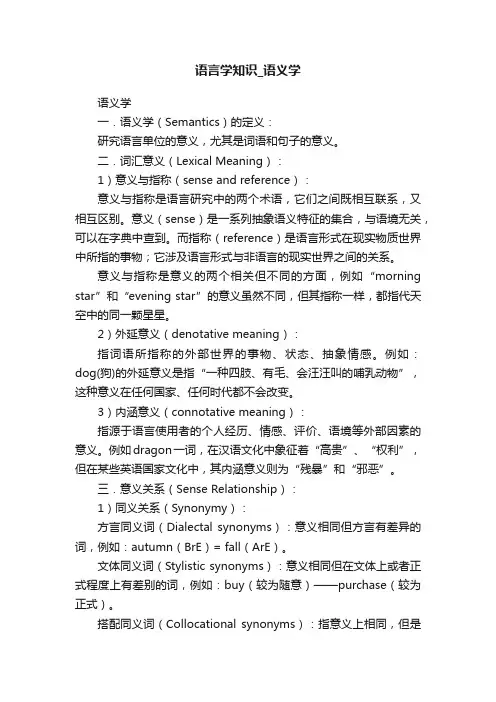
语言学知识_语义学语义学一.语义学(Semantics)的定义:研究语言单位的意义,尤其是词语和句子的意义。
二.词汇意义(Lexical Meaning):1)意义与指称(sense and reference):意义与指称是语言研究中的两个术语,它们之间既相互联系,又相互区别。
意义(sense)是一系列抽象语义特征的集合,与语境无关,可以在字典中查到。
而指称(reference)是语言形式在现实物质世界中所指的事物;它涉及语言形式与非语言的现实世界之间的关系。
意义与指称是意义的两个相关但不同的方面,例如“morning star”和“evening star”的意义虽然不同,但其指称一样,都指代天空中的同一颗星星。
2)外延意义(denotative meaning):指词语所指称的外部世界的事物、状态、抽象情感。
例如:dog(狗)的外延意义是指“一种四肢、有毛、会汪汪叫的哺乳动物”,这种意义在任何国家、任何时代都不会改变。
3)内涵意义(connotative meaning):指源于语言使用者的个人经历、情感、评价、语境等外部因素的意义。
例如dragon一词,在汉语文化中象征着“高贵”、“权利”,但在某些英语国家文化中,其内涵意义则为“残暴”和“邪恶”。
三.意义关系(Sense Relationship):1)同义关系(Synonymy):方言同义词(Dialectal synonyms):意义相同但方言有差异的词,例如:autumn(BrE)= fall(ArE)。
文体同义词(Stylistic synonyms):意义相同但在文体上或者正式程度上有差别的词,例如:buy(较为随意)——purchase(较为正式)。
搭配同义词(Collocational synonyms):指意义上相同,但是搭配不相同的词。
例如:provide和supply,provide sth. for sb.和supply sth. to sb.在情感或评价意义方面存在差异的同义词(Synonyms with different emotive or evaluative meaning):意义相同,但在情感或评价意义方面存在差异的词,例如:politician (政客)含贬义色彩,statesmen(政治家)含褒义色彩。
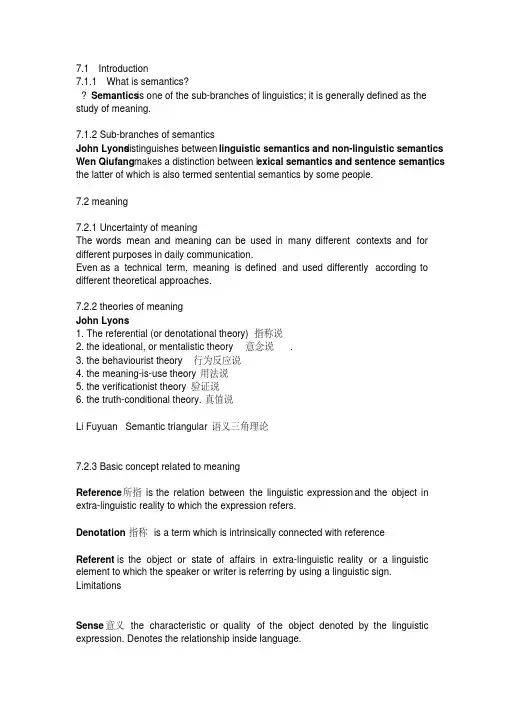
7.1 Introduction7.1.1 What is semantics??Semantics is one of the sub-branches of linguistics; it is generally defined as the study of meaning.7.1.2 Sub-branches of semantics. John Lyons distinguishes between linguistic semantics and non-linguistic semantics, Wen Qiufang makes a distinction between l exical semantics and sentence semantics the latter of which is also termed sentential semantics by some people.7.2 meaning7.2.1 Uncertainty of meaningThe words mean and meaning can be used in many different contexts and for different purposes in daily communication.Even as a technical term, meaning is defined and used differently according to different theoretical approaches.7.2.2 theories of meaningJohn Lyons1.The referential (or denotational theory) 指称说2.the ideational, or mentalistic theory 意念说.3.the behaviourist theory 行为反应说4.the meaning-is-use theory 用法说5.the verificationist theory验证说6.the truth-conditional theory.真值说Li Fuyuan Semantic triangular 语义三角理论7.2.3 Basic concept related to meaningReference所指is the relation between the linguistic expression and the object in extra-linguistic reality to which the expression refers.Denotation指称is a term which is intrinsically connected with referenceReferent is the object or state of affairs in extra-linguistic reality or a linguistic element to which the speaker or writer is referring by using a linguistic sign. LimitationsSense意义the characteristic or quality of the object denoted by the linguistic expression. Denotes the relationship inside language.Extension and intensionExtension is the class of entities to which a linguistic expression is correctly applied Intension is the set of defining properties which determines the applicability of a linguistic expression.Concept is the result of human cognition,reflecting the objective world in human mind.7.2.4 Types of meaningDenotation and connotation 外延意义和内涵意义The denotative meaning of a linguistic form is the person,object, abstract notion, event, or Mate which the word or sentence denotes.We can say that the denotation of a linguistic expression is its dictionary meaning.The main application of the term connotation is with reference to the emotional associations which are suggested by, or are part of the meaning of a linguistic unit, especially a lexical item.Positive neutral negative (Wen Qiufang)7.3Lexical semantics is concerned with the meaning of lexical items.7.3.1 componential analysis成分分析The way to decompose the meaning of a word into its components is known as componential analysis. We can analyze a word as a set of semantic features or semantic components with the values: plus ( + ) or minus ( -)7.3.27.3.2 Semantic field 语义场Words do not exist in isolation. They are always related to each other in one another and form different semantic fields. Semantic field theory is a theory of the German structuralist school:the vocabulary of a language is not simply a listing of independent items, but is organized into areas, or fields, within which words interrelate and define each other in various ways. (Crystal. 1985, 274).7.3.3 Lexical relationsSaeed 8 lexical relations一Form relation 形式关系Homonymy同音(同形)异义关系two or more lexical items are synonyms when they have the same meaningsAbsolute homoyms 同音同形异义词Homopones 同音异义词Homographs 同形异义词二Sense relations 语义关系1.Polysemy一词多义关系 a lexical item has a range of different meanings2.Synonymy同义关系two or more lexical items have the same meanings3.Antonymy反义关系two words are opposite in meaningcomplementary antonymy 互补反义关系Gradable antonymy 等级反义关系Relational opposite 关系对立反义词4.Hyponymy下义关系Hyponym 下义词Hyperonym 上义词三object relations 实体关系1.Meronymy 组成部分与整体关系2.Member-collection 成员与集体关系3.Portion-mass 部分与整体关系Lexical ambiguity is caused by ambiguous words rather than by ambiguous structures and is usually created by polysemy or homonymy.7.4 sentential semanticsSix essential factors for determining sentence meaningi) the meanings of individual words which make up a sentence;ii) grammaticality of a sentence;iii) the linear ordering of the linguistic forms in a sentence;iv) the phonological features like stress and intonation;v) the hierarchical order of a sentence;vi) the semantic roles of the nouns in relation to the verb in a sentence.Nine semantic rolesAgent (施事格)Patient (目标格)Experiencer (经验者)Instrument (工具格)Cause (动因格)Attribute (属性)Recipient (接受者)Locative (方位格)Temporal (时间格)SynonymousEntailContradictPresuppose presupposition triggerTautologyContradictionSemantically anomalous 异常的反常的Predicate谓语argument论元proposition命题。
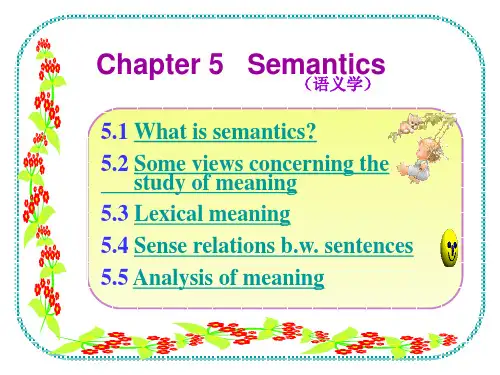
语义学各个领域对语义学的看法语义学(Semantics),也作“语意学”,是一个涉及到语言学、逻辑学、计算机科学、自然语言处理、认知科学、心理学等诸多领域的一个术语。
虽然各个学科之间对语义学的研究有一定的共同性,但是具体的研究方法和内容大相径庭。
一、语言学的语义学研究目的在于找出语义表达的规律性、内在解释、不同语言在语义表达方面的个性以及共性;其主要有三个分支:1结构主义语义学:从20世纪美国结构主义语言学发展而来,研究内容是词汇的意义和结构,如义素分析、语义场等,也可称为词汇语义学,词和词之间的各种关系是词汇语义学研究的一个方面,例如同义词、反义词,同音词等,找出词语之间的细微差别。
2生成语义学:20世纪六七十年代流行于生成语言学内部的一个语义学分支, 借鉴了结构语义学对义素的分析方法,比照生成音系学的音位区别特征理论,主张语言的最深层的结构是义素,通过句法变化和词汇化的各种手段而得到表层的句子形式。
3形式语义学:最初的研究开始于蒙太古以数理逻辑方法对英语的研究,后来经过语言学家和哲学家的共同努力,发展成为一个独立的学科,并且摒弃了蒙太古对生成语言学的句法学的忽视,强调语义解释和句法结构的统一,从而最终成为生成语言学的语义学分支。
二、逻辑学的语义学是对一个逻辑系统的解释,着眼点在于真值条件,不直接涉及自然语言;现代的逻辑学,或者说形式逻辑、数理逻辑等,其目的是设计出来一套形式语言系统,并对其作出语义解释。
这样的形式语言系统是一个个抽象的封闭体系.一个逻辑系统通常由三个部分组成,即词汇部分、句法部分和基于模型论的语义部分。
所谓的词汇部分就是列举出一个形式系统所使用的所有符号,句法部分是这些符号的组合规则,规定什么样的符号序列可以是这个系统的句子,语义部分是对合格句子的解释,这样的解释通常是:在一个模型中进行的对真值条件推导。
逻辑学的语义学着眼点在于逻辑系统的语义解释,是一个理想化的模型系统,不直接涉及自然语言。
semantics名词解释1. Semantics(semantically)意义学,语义学;关于意义的研究。
在语言学中指对词和句子的含义进行探讨,包括各种词汇和语法构造的意思以及它们在具体语境中的运用方式。
例句:1. Semantics is a branch of linguistics that studies the meaning of words and sentences.意义学是语言学的一个分支,研究词汇和句子的含义。
2. Semantic analysis involves examining the structure and meaning of language.语义分析涉及审查语言的结构和含义。
3. The study of semantics is important in understanding how language is used to convey meaning.研究语义对于理解语言如何传达含义至关重要。
4. The semantics of a sentence can change depending on the context in which it is used.一句话的语义会因其所在的语境而有所改变。
5. In semantics, we look at both the denotative and connotative meanings of words.在语义学中,我们关注词语的指示意义和隐含意义。
6. The semantic content of a text refers to its underlying meaning and themes.一段文本的语义内容指的是其潜在的意义和主题。
7. Understanding the semantics of a language is important in accurately translating it into another language.了解一种语言的语义对于准确翻译它到另一种语言至关重要。
Chapter 5 Semantics 语义学1.What is semantics?什么是语义学?Semantics can be simply defined as the study of meaning in language.语义学可定义为对语言意义的研究。
2.Some views concerning the study of meaning语义研究的几种主要理论1)The naming theory 命名论It was proposed by the ancient Greek scholar Plato. According to this theory, the linguistic forms or symbols, in other words, the words used in a language are taken to be labels of the objects they stand for. So words are just names or labels for things.命名论是最原始的语义理论,是古希腊学者柏拉图提出的。
该理论把词看作是该词所指事物的名称或标记。
2)The conceptualist view 意念论The conceptualist view holds that there is no direct link between a linguistic form and what it refers to; rather, in the interpretation of meaning they are linked through the mediation of concepts in the mind.意念论认为,语言形式及其所代表的对象之间(即语言与现实世界之间)没有直接联系;确切地说,在理解语义时,是通过大脑中存在意念这一中介物来联系的。
Semantics1. What is Semantics?Semantics is the study of the meaning of words, phrases and sentences.语义学是研究单词、短语和句子的意义的学科2.Geoffrey Leech利奇Seven types of meaning7种意义类型:①Conceptual meaning概念意义②Connotative meaning内涵意义③Social meaning社会意义④Affective meaning 感情意义Associative Meaning联想意义(②——⑥)⑤Reflected meaning反射意义⑥Collocative meaning搭配意义⑦Thematic meaning主位意义3.Conceptual meaning(概念意义)is also called “denotative”(外延义)and it is concerned with the relationship between a word and the thing it refers to.概念意义也叫外延义,它关注词语跟它所指称事物之间的联系Conceptual meaning is meaning given in the dictionary.4.Associative meaning (联想意义) is the total of all the meanings a person thinks of when they hear the wordAssociative meaning is the meaning which a word suggests or implies.5.Thematic meaning (主位意义) is “what is communicated by the way in which the message is organized in terms of order and emphasis.”它是由词序和词语重音所决定的6. The Referential Theory(指称理论):① The Referential Theory② The Semantic Triangle③ Sense and Reference7.The referential theory指称理论 is the theory of meaning which relates the meaning of a word to the thing it refers to.指称论是把词语意义跟它所指称的事物联系起来的理论8. The semantic triangle语意三角 is the indirect relation between a word and a thing it refers to and it is mediated by concept.语意三角指词和所指事物之间没有直接关系,它们是以概念为中介的9.Sense (涵义) is a set of properties possessed by a name.10.Reference (指称) is the symbolic relationship that a linguistic expression has with the concrete object.11. The sense of an expression is the thought it expresses, while its reference is the object it representsEvery word has a sense, but not every word has a reference.12. Sense Relations涵义关系①Synonymy(同义关系)②Antonymy(反义关系)(Gradable、Complementary、Converse)③Hyponymy(上下义关系)13.But total synonymy is rare. They may differ in style, connotations and dialect.14.Gradable antonymy (等级反义关系) 、Complementary antonymy (互补反义关系)、Converse antonymy (反向反义关系)15. Componential analysis is an approach to the study of meaning which analyses a word into a set of meaning components.16. Sentence Meaning17. Sense relations between sentences①Synonymity (同义)a. He was a bachelor all his life.b. He never married all his boy.Sentences a and b are in a synonymous relationship: the truth of one sentence necessarily implies the truth of another sentence②Inconsistency(矛盾)a. Elizabeth II is Queen of England.b. Elizabeth II is a man.Sentences a and b are in a relationship of contradiction: the truth of one sentence necessarily implies the falseness of another sentence.③Entailment (蕴涵)a. He married a blonde heiress.b. He married a blonde.Entailment refers to a kind of meaning inclusion. If x entails y, the meaning of x is included in y.④Presupposition(前提预设)It is what a speaker or writer assumes that the receiver of the message already knows.⑤Contradiction(矛盾)⑥Semantic anomaly(语义反常)18. An integrated theory﹡Compositionality(组合性原则):the meaning of a sentence depends on the meaning of the constituent words and the way they are combined.﹡This semantic theory is the integration of syntax and semantics﹡Their basic idea is that a semantic theory consists of two parts: a dictionary and a set of projection rules﹡The dictionary provides the grammatical classification and semantic information of words﹡The projection rules are responsible for combining the meanings of words together.19.Logical semantics(逻辑语义学)﹡A proposition(命题) is what is to be expressed by a declarative sentence when that sentence is uttered to make a statement.﹡It is the basic meaning which a sentence express.﹡A very important property of the proposition is that it has a truth value.。
简述语义学词汇意义的七种类型语义学(Semantics),也作“语意学”,是一个涉及到语言学、逻辑学、计算机科学、自然语言处理、认知科学、心理学等诸多领域的一个术语。
虽然各个学科之间对语义学的研究有一定的共同性,但是具体的研究方法和内容大相径庭。
语义学的研究对象是自然语言的意义,这里的自然语言可以是词,短语(词组),句子,篇章等等不同级别的语言单位。
但是各个领域里对语言的意义的研究目的不同。
语言学的语义学研究目的在于找出语义表达的规律性、内在解释、不同语言在语义表达方面的个性以及共性。
语义学是语言学的一个分支,研究所有字面的意义,不考虑语境。
语义学又称作词义学(Semantics,来自于希腊语semantikos),对中文等方块文字而言,则称为字义学.研究对象是词语,是词汇学的一个分支.主要研究词义. 词和词之间的各种关系是语义学研究的一个主要方面,例如同义词、反义词,同音词等,找出词语之间的细微差别,让人们更准确地使用词语.词汇意义:意义的七种类型根据美国的语言学家利奇根据意义的广泛含义可分为7种不同的类型:即概念意义、内涵意义、风格意义、感情意义、反映意义、搭配意义和主位意义。
进而他又将内涵、风格、情感、反映和搭配等5种意义统称为联想意义。
以下我将就这7种意义类型做些简要的评述。
1.概念意义概念意义指的是词语中将其与外部世界的现象联系起来的那部分意义。
也就是说,一个词语的字面意义中所包含的最基本的、最本质的意义成分就是其概念意义。
例如,英语中bird 一词的概念意义是a two-legged,winged,egg-laying,warm-bloodedcreaturewithabeak(两条腿,长有翅膀、能下蛋的,有喙的温血动物)。
概念意义是词语意义体系中的核心意义,是在语言交际中所表达出来的词语最基本的意义。
因此,在词典和语言学习课本中人们常使用概念意义来给词语作注释。
一般说来,语言中词语的概念意义比较稳定,变化不大。
Semantics
1. What is Semantics?
Semantics is the study of the meaning of words, phrases and sentences.语义学是研究单词、短语和句子的意义的学科
2.Geoffrey Leech利奇Seven types of meaning7种意义类型:
①Conceptual meaning概念意义
②Connotative meaning内涵意义
③Social meaning社会意义
④Affective meaning 感情意义Associative Meaning联想意义(②——⑥)
⑤Reflected meaning反射意义
⑥Collocative meaning搭配意义
⑦Thematic meaning主位意义
3.Conceptual meaning(概念意义)is also called “denotative”(外延义)and it is concerned with the relationship between a word and the thing it refers to.概念意义也叫外延义,它关注词语跟它所指称事物之间的联系
Conceptual meaning is meaning given in the dictionary.
4.Associative meaning (联想意义) is the total of all the meanings a person thinks of when they hear the word
Associative meaning is the meaning which a word suggests or implies.
5.Thematic meaning (主位意义) is “what is communicated by the way in which the message is organized in terms of order and emphasis.”它是由词序和词语重音所决定的
6. The Referential Theory(指称理论):
① The Referential Theory
② The Semantic Triangle
③ Sense and Reference
7.The referential theory指称理论 is the theory of meaning which relates the meaning of a word to the thing it refers to.指称论是把词语意义跟它所指称的事物联系起来的理论
8. The semantic triangle语意三角 is the indirect relation between a word and a thing it refers to and it is mediated by concept.语意三角指词和所指事物之间没有直接关系,它们是以概念为中介的
9.Sense (涵义) is a set of properties possessed by a name.
10.Reference (指称) is the symbolic relationship that a linguistic expression has with the concrete object.
11. The sense of an expression is the thought it expresses, while its reference is the object it represents
Every word has a sense, but not every word has a reference.
12. Sense Relations涵义关系
①Synonymy(同义关系)
②Antonymy(反义关系)(Gradable、Complementary、Converse)
③Hyponymy(上下义关系)
13.But total synonymy is rare. They may differ in style, connotations and dialect.
14.Gradable antonymy (等级反义关系) 、Complementary antonymy (互补反义关系)、Converse antonymy (反向反义关系)
15. Componential analysis is an approach to the study of meaning which analyses a word into a set of meaning components.
16. Sentence Meaning
17. Sense relations between sentences
①Synonymity (同义)
a. He was a bachelor all his life.
b. He never married all his boy.
Sentences a and b are in a synonymous relationship: the truth of one sentence necessarily implies the truth of another sentence
②Inconsistency(矛盾)
a. Elizabeth II is Queen of England.
b. Elizabeth II is a man.
Sentences a and b are in a relationship of contradiction: the truth of one sentence necessarily implies the falseness of another sentence.
③Entailment (蕴涵)
a. He married a blonde heiress.
b. He married a blonde.
Entailment refers to a kind of meaning inclusion. If x entails y, the meaning of x is included in y.
④Presupposition(前提预设)
It is what a speaker or writer assumes that the receiver of the message already knows.
⑤Contradiction(矛盾)
⑥Semantic anomaly(语义反常)
18. An integrated theory
﹡Compositionality(组合性原则):the meaning of a sentence depends on the meaning of the constituent words and the way they are combined.
﹡This semantic theory is the integration of syntax and semantics
﹡Their basic idea is that a semantic theory consists of two parts: a dictionary and a set of projection rules
﹡The dictionary provides the grammatical classification and semantic information of words
﹡The projection rules are responsible for combining the meanings of words together.
19.Logical semantics(逻辑语义学)
﹡A proposition(命题) is what is to be expressed by a declarative sentence when that sentence is uttered to make a statement.
﹡It is the basic meaning which a sentence express.
﹡A very important property of the proposition is that it has a truth value.。